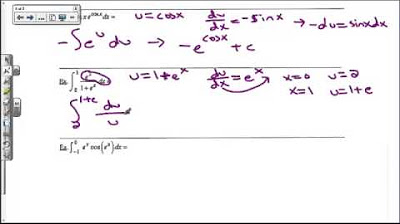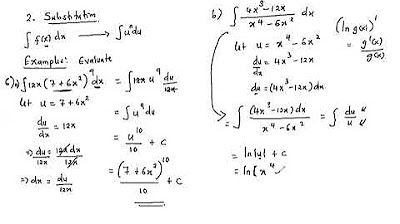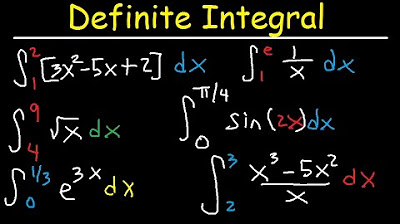Integrating Exponential Functions By Substitution - Antiderivatives - Calculus
TLDRThis video script offers a comprehensive guide on integrating exponential functions. It begins with basic integration of e^(3x) and e^(2x), then progresses to more complex examples involving u-substitution and integration by substitution. The script demonstrates the technique of dividing complex integrals into simpler parts, handling fractions with exponentials in the numerator and denominator, and emphasizes the importance of understanding the properties of exponential functions and their derivatives. The final examples showcase the application of these methods to solve a variety of integral problems, reinforcing the concepts taught throughout the video.
Takeaways
- 📚 The antiderivative of e^(3x) is simply e^(3x) + C, highlighting the property of exponential functions with constant bases.
- 🔄 For the function e^(2x), the antiderivative is (e^(2x))/2 + C, demonstrating the division by the derivative of the exponent.
- 🌟 When integrating e^(-5x), the technique involves using substitution with u = -5x, leading to the result -(e^(-5x))/5 + C.
- 🧠 The concept of substitution is applied to x^4e^x by setting u = x^4, resulting in the antiderivative (1/4)e^u + C.
- 🤔 For the function xe^(sqrt(1-e^x)), the substitution with u = 1 - e^x simplifies the integration process, leading to the antiderivative -(2/3)(1 - e^x)^(3/2) + C.
- 📈 The integration of (e^x + e^-x)/(e^x - e^-x) is achieved by setting u = e^x - e^-x, and the result is the natural logarithm of the absolute value of u plus C.
- 🌠 In the case of (e^(1/x^2))/(x^3), the substitution with u = 1/x^2 yields the antiderivative -(1/2)e^(1/u) + C.
- 🔧 The script illustrates the method of splitting complex fractions, such as (e^(3x) + 4e^x + 5)/e^x, into simpler parts for easier integration.
- 📊 The antiderivative of each term in the split fraction is found by simplifying the exponents and applying basic integration rules.
- 🎓 The script emphasizes the importance of understanding the properties of exponential functions and the application of substitution and simplification techniques in integration.
Q & A
What is the antiderivative of e^(3x) dx?
-The antiderivative of e^(3x) dx is simply e^(3x) + C, where C is the constant of integration.
How is the antiderivative of e^(2x) dx found?
-The antiderivative of e^(2x) dx is calculated by dividing e^(2x) by its derivative, which is 2. So, the antiderivative is (1/2)e^(2x) + C.
What substitution technique is used to integrate e^(-5x) dx?
-To integrate e^(-5x) dx, we use u-substitution. We let u = -5x, then du = -5 dx, and solving for dx gives us dx = du/(-5). After substituting these into the integral, we get the antiderivative as (-1/5)e^(-5x) + C.
How does the u-substitution method work for integrating e^(x^4) dx?
-For integrating e^(x^4) dx, we set u = x^4, which means du = 4x^3 dx. Solving for dx gives us dx = du/(4x^3). Substituting these into the integral and simplifying, we find the antiderivative to be (1/4)e^(x^4) + C.
What is the first step in integrating a function with u-substitution?
-The first step in u-substitution is to choose an appropriate u that simplifies the integral. This usually involves setting u equal to a term or a combination of terms in the integrand that can be easily differentiated.
How do you handle a fraction with an exponential function in the numerator and denominator when integrating?
-When integrating a fraction with an exponential function in both the numerator and denominator, you can first simplify the fraction by canceling out common terms. Then, you can integrate the simplified expression using u-substitution or other appropriate methods.
What is the role of the constant of integration (C) in an antiderivative?
-The constant of integration (C) is added to the antiderivative to account for the infinite number of possible antiderivatives that exist for a given function. It represents the arbitrary constant that can be present in the solution to the differential equation.
How does the derivative of a function affect the process of integration?
-The derivative of a function is crucial in the process of integration because it is the inverse operation. When integrating, you often need to find the derivative of the integrand to apply u-substitution or other integration techniques effectively.
What is the antiderivative of e^(x) times the square root of (1 - e^x) dx?
-To find the antiderivative of e^(x) times the square root of (1 - e^x) dx, we first let u = 1 - e^x, then du = -e^x dx. Solving for dx gives us dx = -du/e^x. The antiderivative is then (-2/3)(1 - e^x)^(3/2) + C.
How do you integrate a function that has a term in the numerator and the same term in the denominator?
-When a function has a term in both the numerator and the denominator, you can often simplify the expression by canceling out the common terms. Then, you can integrate the simplified expression using the appropriate integration techniques.
What is the antiderivative of e^(-x)/x^3 dx?
-To find the antiderivative of e^(-x)/x^3 dx, we first let u = 1/x^2. The derivative of u with respect to x is du = -2/x^3 dx. Solving for dx gives us dx = du/(-2x^2). Substituting these into the integral, we get the antiderivative as (-1/2)e^(-x)/x^2 + C.
What is the final answer for the integral of e^(x)/(x^3) dx?
-The final answer for the integral of e^(x)/(x^3) dx is (-1/2)e^(x)/x^2 + C, after substituting back u = 1/x^2 and simplifying the expression.
Outlines
📚 Integration of Exponential Functions
This paragraph delves into the process of integrating exponential functions. It begins with the antiderivative of e^(3x) and explains that the answer is simply e^(3x) + C. The video then tackles the integration of e^(2x) by dividing it by its derivative, 2. A key concept highlighted is that this technique works only for division by constants. The paragraph further explores the integration of e^(-5x) using u-substitution, demonstrating the steps to arrive at the final answer of -1/5 * e^(-5x) + C. The technique of u-substitution is also applied to integrate x^4 * e^(x^4), resulting in 1/4 * e^(x^4) + C. The paragraph concludes with the integration of a more complex function, e^(x) * √(1 - e^x), and explains the process of substitution and simplification to obtain the final answer.
🧠 Advanced Integration Techniques
The second paragraph focuses on advanced integration techniques, starting with the integration of a function involving x and e^(x). The video explains the use of substitution, setting u as 1 - e^x, and solving for dx in terms of du. The final answer is presented as -2/3 * (1 - e^x)^(3/2) + C. The paragraph then moves on to the integration of a complex fraction involving e^(x) and e^(-x). Through the process of substitution and simplification, the video derives the natural logarithm of the absolute value of (e^(x) - e^(-x)) + C. The paragraph concludes with the integration of e^(1/x^2) / x^3, using substitution to find the antiderivative, which is -1/2 * e^(1/x^2) + C.
🔢 Fractional Exponential Integration
This paragraph addresses the integration of a fraction where the numerator is a sum of exponential terms and the denominator is e^x. The video script outlines the strategy of splitting the fraction into three separate fractions, each easier to integrate. The paragraph explains the process of simplifying each term by subtracting exponents and integrating term by term. The final answers for each term are combined to provide the overall solution, which includes e^(2x)/2, 4x, and -5e^(-x)/1 + C, showcasing the methodical approach to dealing with fractional exponential functions.
Mindmap
Keywords
💡Antiderivative
💡Exponential Functions
💡Integration
💡Substitution
💡Derivative
💡Constant
💡Integration by Substitution
💡Chain Rule
💡U-Substitution
💡Integration Techniques
💡Arbitrary Constant
Highlights
The antiderivative of e^(3x) dx is simply e^(3x) + C.
For the function e^(2x), the antiderivative is e^(2x)/2 + C, using the property of dividing by the derivative of the exponent.
The antiderivative of e^(-5x) is found to be the same as the previous example, e^(-5x)/-5 + C.
U-substitution is used to prove the antiderivative of e^(-5x) by setting u as -5x and solving for du/dx.
For the integral of x^4 * e^(x^4) dx, substitution with u as x^4 simplifies the integration process.
The antiderivative of x^4 * e^(x^4) is 1/4 * e^(x^4) + C after substitution and simplification.
Integration by substitution is applied to the function involving e^(x) * sqrt(1 - e^x) dx.
The antiderivative of e^(x) * sqrt(1 - e^x) is -2/3 * (1 - e^x)^(3/2) + C after solving for du/dx and integrating.
For the complex function (e^x + e^(-x)) / (e^x - e^(-x)), the integration involves setting u as e^x - e^(-x) to simplify the expression.
The natural log function arises in the antiderivative of the complex function, resulting in ln(u) + C.
The antiderivative of e^(1/x^2) / x^3 dx is found by setting u as 1/x^2 and solving for dx, resulting in -1/2 * e^(1/x^2) + C.
The technique of splitting the fraction into smaller parts is used to integrate (e^(3x) + 4e^x + 5) / (e^x) dx.
Integration of the split fraction reveals the antiderivative to be 2x/2 - 1/x - 5/x + C.
The video demonstrates the use of exponent rules and substitution methods for integrating exponential functions.
The antiderivative of e^x involving different techniques showcases the flexibility in solving integrals.
The video provides a comprehensive guide on integrating exponential functions with various methods.
Transcripts
5.0 / 5 (0 votes)
Thanks for rating:





